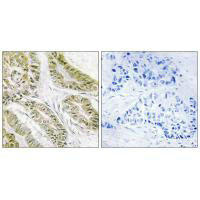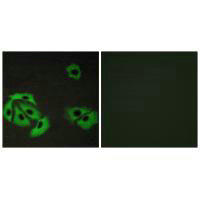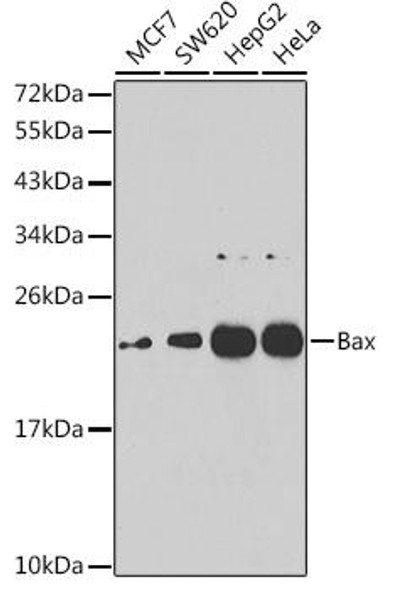| UniProt Protein Function: | BAX: Accelerates programmed cell death by binding to, and antagonizing the apoptosis repressor BCL2 or its adenovirus homolog E1B 19k protein. Under stress conditions, undergoes a conformation change that causes translocation to the mitochondrion membrane, leading to the release of cytochrome c that then triggers apoptosis. Promotes activation of CASP3, and thereby apoptosis. Homodimer. Forms higher oligomers under stress conditions. Interacts with BCL2L11. Interaction with BCL2L11 promotes BAX oligomerization and association with mitochondrial membranes, with subsequent release of cytochrome c. Forms heterodimers with BCL2, E1B 19K protein, BCL2L1 isoform Bcl-X(L), BCL2L2, MCL1 and A1. Interacts with SH3GLB1 and HN. Interacts with SFN and YWHAZ; the interaction occurs in the cytoplasm. Under stress conditions, JNK-mediated phosphorylation of SFN and YWHAZ, releases BAX to mitochondria. Isoform Sigma interacts with BCL2A1 and BCL2L1 isoform Bcl-X(L). Interacts with RNF144B, which regulates the ubiquitin-dependent stability of BAX. Interacts with CLU under stress conditions that cause a conformation change leading to BAX oligomerization and association with mitochondria. Does not interact with CLU in unstressed cells. Interacts with FAIM2/LFG2. Interacts with human cytomegalovirus/HHV-5 protein vMIA/UL37. Expressed in a wide variety of tissues. Isoform Psi is found in glial tumors. Isoform Alpha is expressed in spleen, breast, ovary, testis, colon and brain, and at low levels in skin and lung. Isoform Sigma is expressed in spleen, breast, ovary, testis, lung, colon, brain and at low levels in skin. Isoform Alpha and isoform Sigma are expressed in pro- myelocytic leukemia, histiocytic lymphoma, Burkitt's lymphoma, T- cell lymphoma, lymphoblastic leukemia, breast adenocarcinoma, ovary adenocarcinoma, prostate carcinoma, prostate adenocarcinoma, lung carcinoma, epidermoid carcinoma, small cell lung carcinoma and colon adenocarcinoma cell lines. Belongs to the Bcl-2 family. 8 isoforms of the human protein are produced by alternative splicing.Protein type: Membrane protein, integral; Tumor suppressor; Mitochondrial; ApoptosisChromosomal Location of Human Ortholog: 19q13.3-q13.4Cellular Component: mitochondrial permeability transition pore complex; pore complex; mitochondrial outer membrane; endoplasmic reticulum membrane; mitochondrion; membrane; endoplasmic reticulum; nuclear envelope; nucleus; cytosolMolecular Function: identical protein binding; protein binding; protein homodimerization activity; channel activity; protein heterodimerization activity; BH3 domain binding; lipid bindingBiological Process: hypothalamus development; viral reproduction; positive regulation of apoptosis; regulation of cell cycle; response to toxin; myeloid cell homeostasis; germ cell programmed cell death; B cell apoptosis; germ cell development; regulation of mammary gland epithelial cell proliferation; spermatid differentiation; development of secondary sexual characteristics; regulation of mitochondrial membrane potential; protein insertion into mitochondrial membrane during induction of apoptosis; establishment and/or maintenance of transmembrane electrochemical gradient; negative regulation of neuron apoptosis; negative regulation of protein binding; kidney development; release of cytochrome c from mitochondria; positive regulation of B cell apoptosis; regulation of protein homodimerization activity; vagina development; protein oligomerization; fertilization; unfolded protein response, activation of signaling protein activity; induction of apoptosis via death domain receptors; DNA damage response, signal transduction resulting in induction of apoptosis; retina development in camera-type eye; negative regulation of fibroblast proliferation; reduction of endoplasmic reticulum calcium ion concentration; glycosphingolipid metabolic process; mitochondrial fragmentation during apoptosis; cerebral cortex development; regulation of nitrogen utilization; post-embryonic camera-type eye morphogenesis; regulation of protein heterodimerization activity; positive regulation of pigmentation; T cell homeostatic proliferation; apoptosis; positive regulation of apoptosis involved in mammary gland involution; negative regulation of peptidyl-serine phosphorylation; neuron migration; response to salt stress; release of matrix enzymes from mitochondria; positive regulation of protein oligomerization; apoptotic mitochondrial changes; B cell homeostatic proliferation; ovarian follicle development; B cell homeostasis; positive regulation of neuron apoptosis; response to gamma radiation; response to axon injury; B cell negative selection; protein homooligomerization; caspase activation; mitochondrial fusion; transformed cell apoptosis; Sertoli cell proliferation; odontogenesis of dentine-containing teeth; neuron apoptosis; endoplasmic reticulum calcium ion homeostasis; homeostasis of number of cells within a tissue; retinal cell programmed cell death; blood vessel remodeling; positive regulation of release of sequestered calcium ion into cytosol; caspase activation via cytochrome c |
| NCBI Summary: | The protein encoded by this gene belongs to the BCL2 protein family. BCL2 family members form hetero- or homodimers and act as anti- or pro-apoptotic regulators that are involved in a wide variety of cellular activities. This protein forms a heterodimer with BCL2, and functions as an apoptotic activator. This protein is reported to interact with, and increase the opening of, the mitochondrial voltage-dependent anion channel (VDAC), which leads to the loss in membrane potential and the release of cytochrome c. The expression of this gene is regulated by the tumor suppressor P53 and has been shown to be involved in P53-mediated apoptosis. Multiple alternatively spliced transcript variants, which encode different isoforms, have been reported for this gene. [provided by RefSeq, Jul 2008] |








